Temples and Caves, 64 Yoginis and Rajarani Music Festival
Monday morning after breakfast we saw a few temples in Bhubaneswar – “the city of 1000 temples”; I did not count but do not doubt 🙂 – and in one temple joined a small puja ritual. We also saw the famous Lingaraj Temple from the outside – again “for Hindus only”. (The name means “The King of Lingams“, the symbolic form of Lord Shiva). Here you see how they change the flags on top of the temple tower – see in the second image how the man climbs down along a rope…

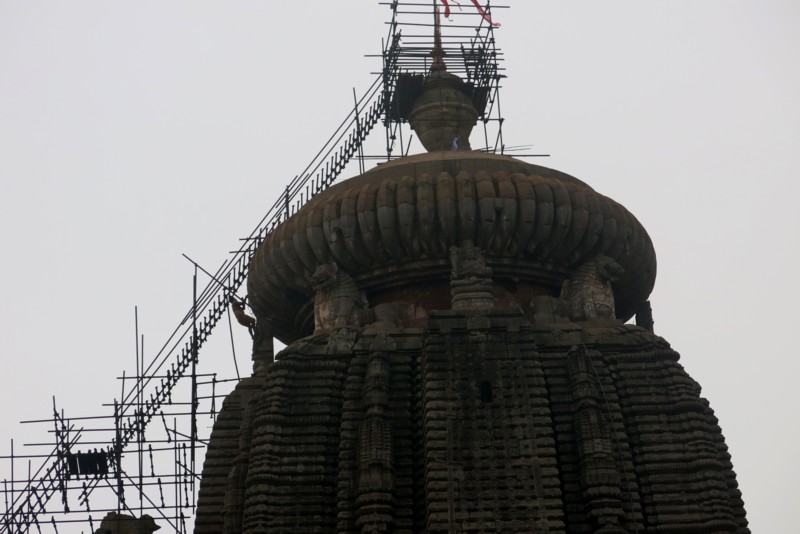
We afterwards drove through narrow streets, a long congestion at a railway crossing and various villages to the Udayagiri and Khandagiri Caves, the abodes of Jain ascetics. There are about 35 caves in two hills, and on the top of one hill there is a Jain temple. They are partly natural and partly carved out from the rock.

One cave looked like a tiger mouth, other structures resembled huge serpents. When we met in the biggest cave for a short meditation, a lady with her daughter asked us if we were meditating and presented herself to be a yoga teacher from the Bihar School of Yoga. Rosa asked her if she would like to lead the meditation. The lady several times asked if we really wanted her to do it, and we said, yes. Then she guided us through a process of visualisation and mantra exercises – a nice experience. After a coconut drink we set out to climb the second hill. On the way up there was a Hindu temple in one of the caves, where the swami performed a ritual and explained about the high age of the encarvings down there, much older than in the other caves or in the Jain sanctuary at the top.

Washing the feet for one rupee before entering the compound of the temple – a boy was spraying water on our feet, and one of our group said, that’s a good business model – very cheap but if all the many visitors have to pay – and can pay – it sums up….
The Jains are completely vegetarian and they also exclude onions, potatoes, eggplants and garlic. So Miquel said at the entrance of the temple, that we also don’t eat onions and garlic – to be allowed to enter – but no photos allowed in and around the temple. There were statues of Mahavira and other Tirthankaras – omniscient teachers.

After returning into the valley we went to the Chausathi Yogini Temple located in a small village on the countryside near a pond. It is an open circular temple with 27.4 m circumference and a wall of 2.4 m – with 64 statuettes of yoginis and Shaivaite goddesses, like Ganeshini, a female form of Ganesha:

Of course, the Brahmin priests which arrived when we came performed a puja, and of course they wanted again rupees. Miquel, the “guardian” of the group cash, remained hard when their demands exceeded what was considered to be “normal”.
After a lunch in a vegetarian restaurant the group wanted to visit more temples in Bhubaneswar. I, however, felt an “overkill” of temple impressions and stayed out during the visit of the Mukteswar temple and other sanctuaries in the surroundings. I said I preferred to be in a meditative place and not go from one place to the other. However, I very much enjoyed when we visited the Shirdi Baba temple in Bhubaneswar – I feel deeply linked to this energy and the short meditation there recharged my system.

The Mukteswar temple, where we had seen a beautiful dance presentation three days before.
Afterwards we went to the site of the Rajarani Temple. It was just the time for the start of the free 3 days “Rajarani Music Festival” with great performances of Indian classical music, again organised by Odisha Tourism.

There were two concerts, one of an Odissi vocal singer, Smt Mohapatra Minati Bhanja, and one of two Hindustani vocal singers, the Wadali Brothers in Sufi tradition. The site was again marvellously decorated, though there was not the magic of the light and movements of the dance performances at the Mukteswar temple.

The first concert was more elegiac, the musical voice of Minati accompanied by a violin, tablas, and string instruments. The second concert rose from yearning vocal patterns to ecstatic rhythms which got the entire audience clapping their hands to the sounds of the two elderly brothers and their group of singers. The sounds rose up into the night-blue sky, from where the moon in his tenth ascending phase shed down his mild light. And the fading of the battery of my camera saved me from taking more pictures of the event…

- Starting our temple tour
- God is also in the cat – a relief above the entrance
- A shiva lingam inside the tower
- Butter lamps in front of the temple, where we joined the first puja
- Ganesha
- The Lingaraj Temple
- Miquel pointing to the man hissing the flag
- At the Udayagiri Caves
- Monkeys playing on a bench
- A rock cave in the mouth of a tiger
- Sitting in the huge cave for meditation
- Rosa, the yoga teacher and her daughter
- Goddess Kali
- The Yogini temple
- Magic ambiance at Rajarani
- Presentation of the Wadali Brothers


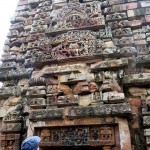

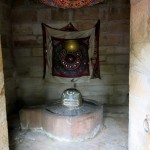

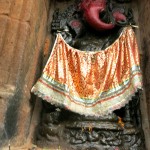
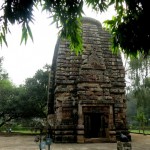
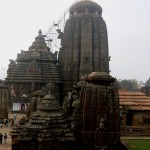


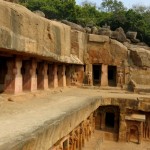

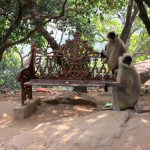
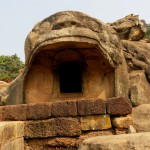

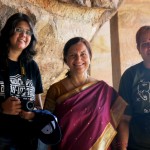

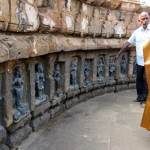
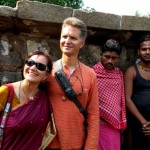
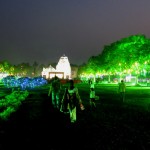
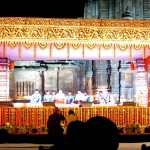

January 23rd, 2016 at 7:19 am
Sir,
Namasthe! Thanks for the tour narrations.
I have a silly doubt how you could manage your food during this tour all along. Since your dietary habits are different and ours are different, there must be some sort of power within your self or some Divine power from the Masters must be helped you to run thru all these days.
Orissa/Odisha has rich cultural heitage for that matter India is itself has a rich cultural heritage in the areas of literature, dance, music, arts and sports etc. Ancient times recorded great cultures at par with Greece, Rome etc.
Thanks and regards
January 23rd, 2016 at 9:10 am
Namasthe, dear Mr. Murthy
This is not at all a silly question. I will write more about it how I caught a heavy vomiting diarrhoea on the way back from India. I myself wondered that I stayed stable so long, longer than in previous years – I often returned seriously sick in earlier years, once for 6 months. This time it was just 2 days, beginning on the flight back – indeed divine blessings from the MASTER.
And really, Odisha’s cultural heritage is tremendous – interesting to note that some of the great temples (Mukteswar) were constructed at the same time while in Europe the gothic cathedrals were rising towards heaven in honour of God.
January 23rd, 2016 at 10:39 am
Dear Mr. Murthy,
The food in Orissa is very good. we had our breakfasts in the hotel after meditation, idlis, sambar, paratha, upma, toasts, muesli, bananas, papaya, pineapple, chai, coffee, tea. Free Buffet.
Then coconuts for drink, and south indian tali for lunch or paneer or dosas. All very taste. For dinner some dry fruits like cashews, almonds banana or curd. Also some day Orissa Tali, very different taste and items. In Puri we ate a very good Panners and talis in a restaurant next to the temple outside. We avoid to eat in the middle of the streets, as Master always recommend us not to do, and we chosed Pure Vegetarian and simple restaurants, with nice Talis. Cashews bought near the temples, for snacks during the day were also very welcome!
Food was very good everywhere, but the energies that we have been submited are very strong, and they are working in us to give us better health in the future and removing all that is not necessary now. We feel very blessed to had the opportunity to visit the holly and sacred land of Orissa, our first time in this life.